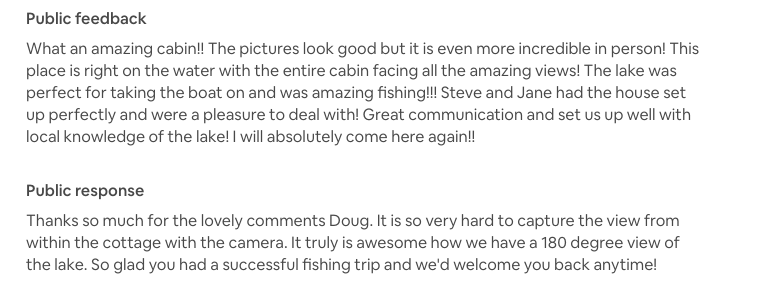Lessons learned as an Airbnb Superhost
When renting out my first cottage, it was with the goal of earning just enough revenue to cover the property taxes and insurance. That way, it would end up being 100% no cost for me to use. Now, having been an Airbnb host for four different properties with an average 4.97 star rating and Super Host status under my belt, I’d say I’ve been pretty successful. Rather than just covering expenses, short term rental has become key to augmenting my income while sharing my little piece of heaven with others.
personal lessons learned as an airbnb superhost
Here are my own personal lessons learned from short-term renting of a vacation property and also my current rental property which is my full time home.
1. Check your insurance policy
While Airbnb does provide a Host Guarantee and Host Protection Insurance, short term rentals may actually void your insurance policy. I contacted my insurer when renting out the first cottage, to let them know and they just cancelled the policy entirely without any discussion! I had to shop around for another insurer.
And be clear on what can be included in the rental. For instance, while I would have loved to offer the use of the kayaks, no watercraft can be included as the insurer saw it as a liability. While it costs a bit more to insure a short term rental, the peace of mind is more than worth it.
2. Choosing a rental service
Having read up on Airbnb, I decided to go with this online service as I was comfortable with the trust economy they had developed where both guests and owners review each other so you’re both putting your best foot forward. Their host guarantee also offered extra piece of mind should something go amiss. I also liked that they take a small service fee from the owner rather than a larger percentage like other services. I did also try VRBO but didn’t like the experience. It’s a big leap of faith renting out your cottage or home and you need to feel comfortable doing it.
3. Declutter and stage
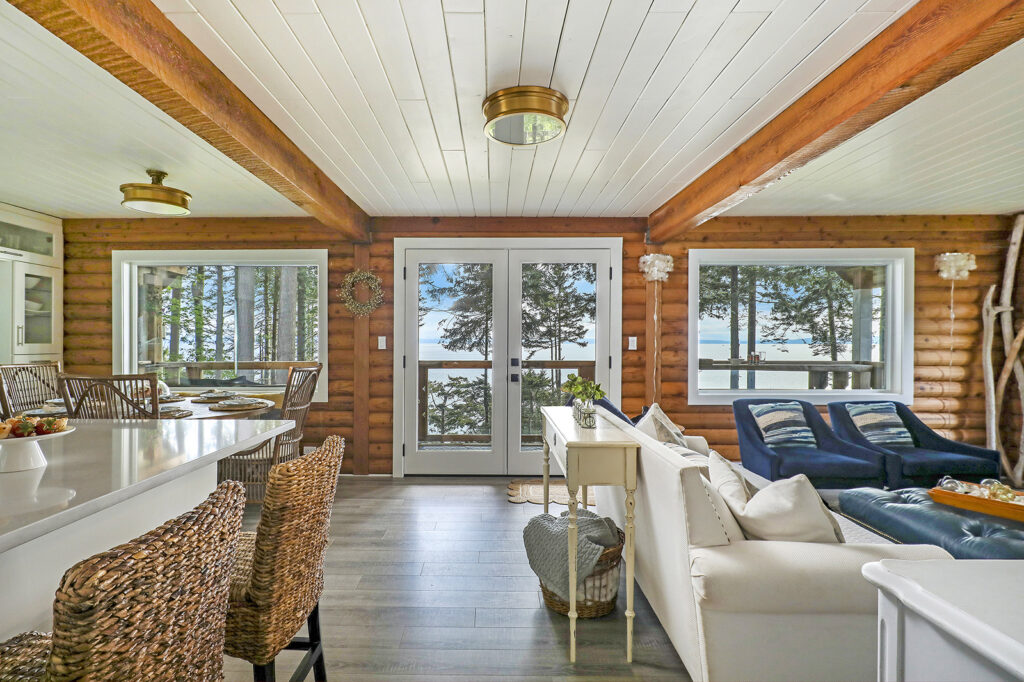
The first step in renting out the cottage is to declutter and stage it. Even though I’d only owned this cottage for two years, it’s pretty eye opening as to how much stuff one cottage can accumulate in such a short time. I went through it with fresh eyes and took away anything that was too personal – ie no family photos. I also don’t have anything of value at the cottage that anyone could easily break or worse, walk off with. Each time I took a picture, I would look at it and realize that there was still clutter. So I’d go back and take away more and retake the photo. There were many trips to the “share shed” where all those extra items were donated.
When designing the space for guests, I had to think about not how I used it but how will guests will use it. If you’d like to know more, here’s a post on designing for short term rentals.
4. Take good accurate photos and lots of them

Good pictures are key. People may not read the description but they’ll flip through the photos. And you can’t have too many of them. I highly recommend hiring a professional photographer. Take pictures of rooms from different angles so renters can get a sense of the entire space.
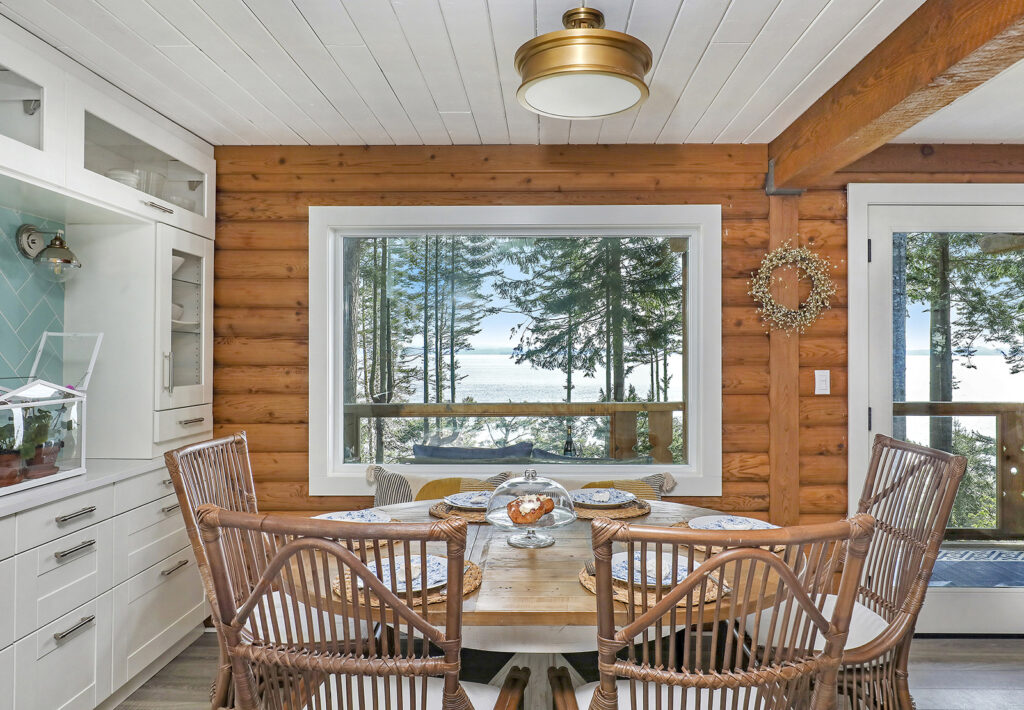
I tried as best as possible to take lifestyle pictures so that guests could imagine themselves staying at the cottage. The table is set, delicious pastries are displayed, beer on the deck, etc… Featuring what other activities they could enjoy both at the cottage and the surrounding area in the detailed listing description gives potential renters the full picture.

5. writing the listing description and naming your listing
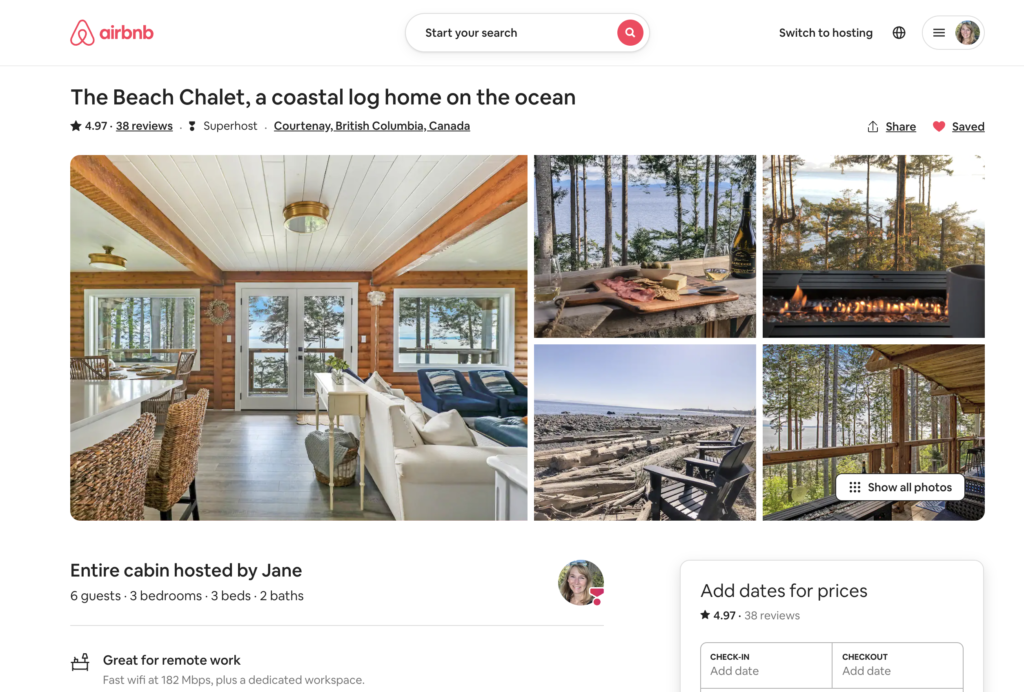
You have to grab people’s attention with the name of your listing. Keep in mind that Airbnb will pull up listings from all over the area so say exactly where you’re located and what sets you apart. The decor of my cabin is a showstopper. But so is the ocean view. Okay, there are a few showstoppers. And doesn’t Beach Chalet sound more sophisticated than cabin?
I was also very specific as to the location of the cabin – it’s on the OCEAN people. A bit in your face I know but people are flipping through the listings so quickly you have to reach out and give them a bit of a slap so they’ll pay attention.
The headline is limited in how many characters you can use, so play around. You can also change up the name to see if you get a better response. I’ve played with it lots and this seems to work. Even though Airbnb doesn’t acknowledge that “beachy” is a word.

In the listing itself, I was extremely truthful so that the guests knew exactly what to expect. The key to good reviews is people having the experience they had envisioned. Otherwise disappointed guests will share it with everyone. And good reviews are the key to future bookings. If there are any negative aspects to your property, be upfront about it. For instance, when the wind blows a certain direction, I’m on the flight path to the airport. However this is rare and sometimes F18’s will fly over as well as search and rescue helicopters which many considered a bonus! But keep in mind that not everyone reads the listing which makes ample photos key.
6. Setting the price
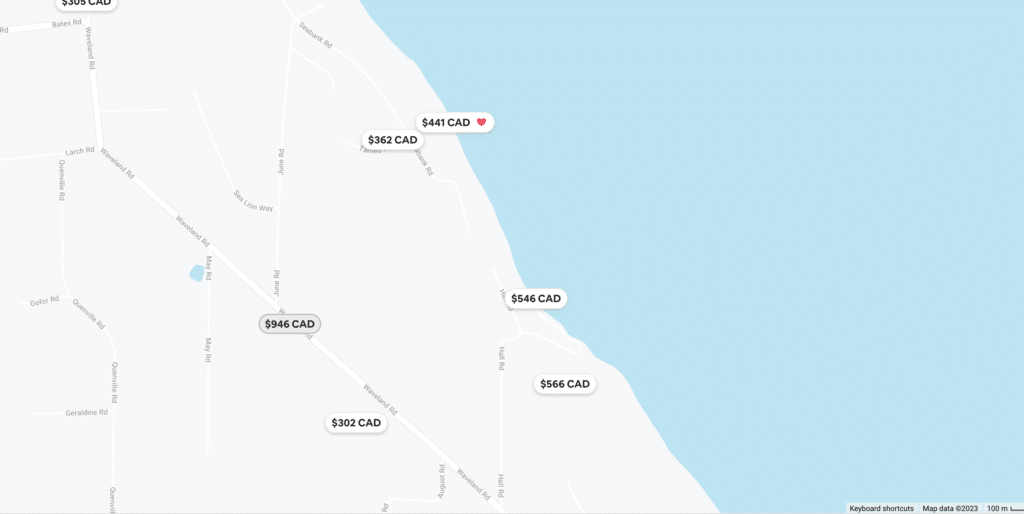
You get decide how much to charge for your rental. Go on to Airbnb and search for other vacation properties in your area. See what they’re charging based on the amenities and number of people they can sleep. How does yours compare? Then set the price somewhat lower as with no reviews, people are taking a chance by renting with you. You can change the price at any time and you can also price different days of the week and seasons differently. Airbnb also offers “smart pricing” which is based on supply and demand. Just keep in mind that they want as many rentals as possible so what’s smart for them might not be smart for you. I started low but now with stunning reviews can command a higher price.
The task of collecting payment is entirely in the hands of Airbnb. The price is the price. I had one potential renter try to negotiate with me but the rest just accepted the price. The payment is released automatically the day after check in but usually takes a few days to show up. You can have the funds directly deposited to your bank account or use Pay Pal (but note that Paypal takes a percentage) The process is clean, simple and no one gets burned.
7. Manage the calendar
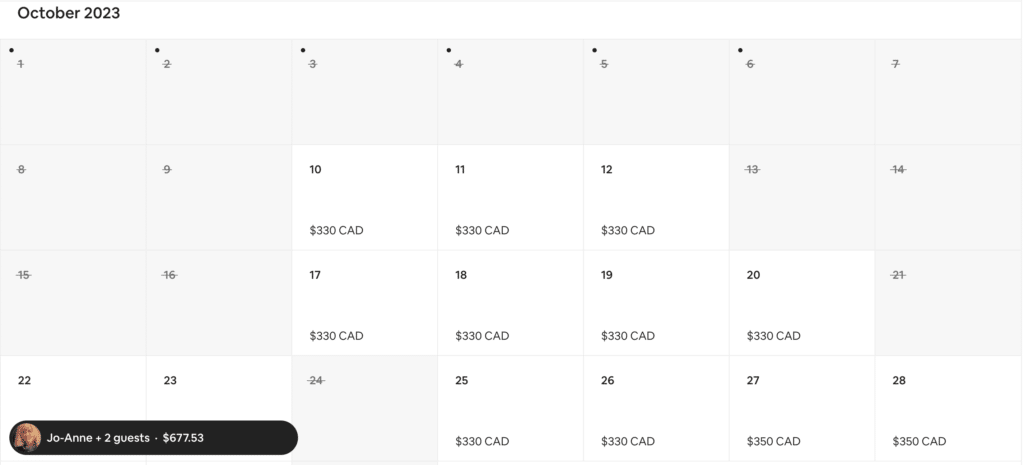
Unless you block it off, your calendar is wide open for people to book any date. I had requests that were too short notice and I wasn’t able to have the cottage cleaned and prepped in time. I learned that you can set your preference for how much advance notice you require. Block off any times that you want to use the cottage far in advance. You can also set the booking window if you only want people to be able to book six months in advance, for instance. Maintaining an accurate calendar saves time for everyone. And it helps with your algorithm…
8. Play the algorithm
Where your listing comes up in search results is based on an algorithm. Now I’m no expert but I have learned that the more often you update your listing, the more that the algorithm likes your listing and the higher you rise in the search results. You want to come out on the first page of results, ideally at the top. So adding photos, adding ideas to the guestbook, updating your calendar, responding to requests on a timely basis all will help keep your listing front and centre. And get your friends and family to “favourite” it but clicking on the heart.
9. Respond right away to requests
Being unfamiliar with the system when starting out, I made a couple of mistakes. On my first request, as we were going back and forth in our communication, I inadvertently let the booking time out (it expires after 24 hours) which meant that the guest had to send a new request – not good for the algorithm. The potential guest was also new to Airbnb so we both had lots of questions for each other. Through the questions, I realized what needed to be added to the listing. For instance, she asked if bedding was available which it was so I added that. I also included it in photographs as not everyone will read the listing description carefully. You can add captions to each photograph.

One thing I also realized was that until the booking is confirmed, you can’t share info such as phone numbers, email addresses or website addresses. It’s a good safety measure that protects everyone from fraud. One potential renter reached out to me but said that she was having a hard time with the Airbnb system and could she just make arrangements with me outside of the system? I suspected that she was older and it wasn’t a scam but I refused as I explained to her that I needed the host guarantee provided by Airbnb and that her money would also be secure. In the end, she managed to get it figured out and booked.
A typical request
Typically when someone makes a request, they talk a little bit about themselves. For instance, they might say that it’s a husband and wife or a family, where they’re travelling, what they’re looking for and ask a question or two. Here’s an example of a traveller from Iceland:
Dear Jane, me and my boyfriend are planning to visit Canada in September. We plan to travel mainly in the British Columbia. We really like your cosy cottage and it would be great if you would like to be our host 🙂 We are an easy going couple, responsible and we respect others people`s property. We’ve read the description of your cottage but we didn’t find any information about the toilet and the shower/tub. Is there a bathroom in the cottage? 🙂
By knowing a bit more about each potential renter, it makes me feel more comfortable that a group of partiers won’t be at my cottage. It’s also part of the fun of getting to know people from all over the world. This is not a hotel and people understand that they’re renting someone’s cottage which is very special to them. If someone sends a very basic enquiry, say for four people, I have no qualms about writing back and asking for more information on all the guests. I have every right to know who is staying at my cottage. Keep in mind though, you won’t see their picture or their last name until the request is accepted. This is a way of ensuring that hosts don’t discriminate.
10. Vetting potential guests
If someone has used Airbnb before, they should have reviews. Check out their reviews before making your decision to accept their booking request. That is the beauty of Airbnb. You’ll both be reviewed which means that as a host you want to provide the best stay possible and as a guest, you want to be responsible and considerate. Here’s an example of a renter’s review that I was able to read in advance of accepting their booking request:
Iain and his family were great guests. They were communicative of their needs before they arrived and made sure to inform us of their estimated time of arrival. I did not personally meet Iain, but my mother did and she found him and his family friendly and warm. They left our place very clean and we would recommend them to other hosts without reservation.
Airbnb also has a way of verifying guests by asking that they provide government issued ID. So look to see if the guest has been verified, especially if they are brand new to Airbnb and have no reviews. I always require verified ID. There was one request that I was extremely nervous about accepting – a bachelorette party! The person I was communicating with was a maid of honour for her sister’s wedding and she had been tasked with organizing a trip that involved fishing, campfires, hiking and good food. She was extremely open and honest about the intent of the trip, assuring me that the five young women would not be loud partiers but just wanted to enjoy each others’ company before the wedding. I reluctantly agreed and they were true to their word as I followed up with the neighbours.
If you’re comfortable, accept the request! I know it’s nerve wracking but oh so rewarding.
11. The welcome message
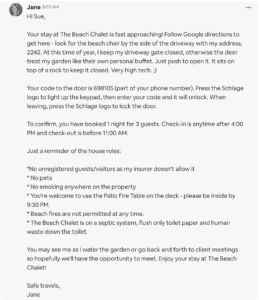
The first booking and the nerves kick in! In the early days, I could respond individually to each new guest but as the bookings started to flow in, it was tiring typing out the same thing every time. On Airbnb, you can create saved messages for responding to guests. I have a saved message relating to check in. A few days before the guest’s scheduled arrival, they receive a message confirming their check in time and the code for the door. I suggest if there is something particular they may want to pack. Our floors can be a bit chilly so I suggest slippers. And the wildlife viewing is pretty sweet so they may want to bring binoculars.
As I’ve experienced common questions from renters, I provide the answers in this canned message, effectively pre-empting the question. Then I also remind them that check out time is 11am and to send me a quick message when they leave. As I never meet our guests, I also send a message once they’ve checked in to ensure the cottage meets their expectations and to see if they have any questions.
12. The cottage manual
I created a “cottage manual” which I email to people once the booking is confirmed and also leave a hard copy in the cottage. This contains info such as a description of the lake, a map on how to find the place downloaded from google, what to expect weather wise, sleeping arrangements, what to do if the power goes out, what happens in the event of a wildfire (climate change is real), garbage and recycling, septic, safety, suggestions for activities, wildlife, where to dine in the area, area activities, local amenities, useful websites, contact info and a thank you message for choosing my cottage with a request to write a review. As many guests are travelling from outside the country, they may not have had access to cell service so I want to ensure they had all the info they need in advance.
Airbnb also has a “guidebook” section on your listing and I’ve ensured that this is full of great suggestions as well.
13. Inform thy neighbours
Speaking of neighbours, it’s important to let them know of your rental intentions. That way, they’re not concerned about strange cars showing up at your cottage. And you don’t want to do anything to jeopardize your relationship with your neighbours. I made sure the neighbours had my cell number so that if there were any disturbances, they could call me at any time and I would immediately take action. I was also clear with the renters about this as well. Not once has there been an issue. In fact, sometimes the renters get invited over to the neighbour’s campfire.
14. Prepping the cottage
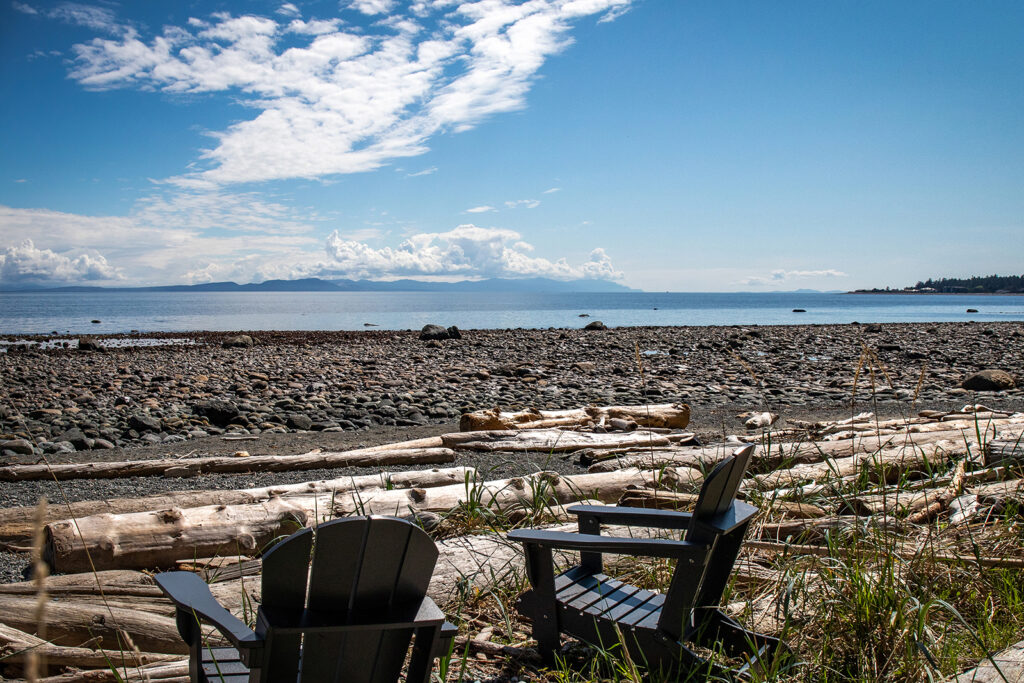
Now this is a whole other blog post as there is lots involved. Don’t let it intimidate you though! Having the place rented out creates incentives to get jobs done that need to be done anyway. A good kick in the pants, so to speak.
15. Check in
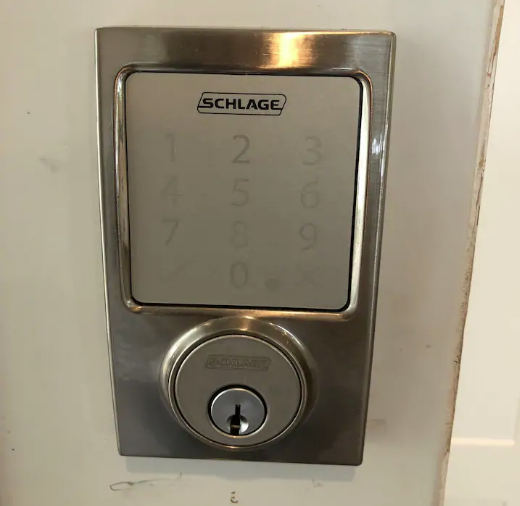
Guests check in on their own with a keyless entry. Each guest has their own specific code that only works for the time of their stay. It can be programmed remotely. There is also a key hidden should the batteries fail. An alert is received when the guests unlocks the door. Then I can send them a message just asking if everything meets their expectations and if they have any questions. Then they’re left alone to enjoy their vacation.
16. The reviews
Now come the reviews. Once a guest has checked out, I like to send a little “Thank you for staying with us, have a safe trip home and please leave a review” message. Airbnb also automatically sends a notification. You both have two weeks to post a review. You can’t see what the other has written until both reviews have been submitted to Airbnb. This system keeps everyone honest and means that you’re not writing a reaction to the other’s review. You will have the opportunity to respond either privately or publicly to a review, once its live.
For me to write a review is a little challenging for two reasons. The first is that I never actually meet the guests so can only really comment on how well they communicated in advance. Secondly, I rely on our cleaner to let me know in what condition the cottage was left and she might not pick up on things that I would. Here’s an example of one of the reviews I posted on a renter:
Miquel was great to communicate with in advance. I felt very comfortable renting to him. His group left the cottage clean and tidy. I didn’t have the opportunity to meet Miquel but wouldn’t hesitate recommending him as a guest.
Once I post my review, I wait anxiously to read the guest’s review. I have always been so touched when they come through. Here is an example:
That’s a lot of exclamation marks!!! This fresh perspective really gives me a new appreciation for what I take for granted as both cottager and Canadian – the fresh pine scented air, the sound of the birds, the wildlife, decompressing on the deck. The cottage is a rare experience for the majority of the world’s population and this reminded me of just how fortunate I am.
I always take a minute to respond to the review. It shows future guests that I’m a responsive host.
The cottage is now booked solid based on the reviews with a wait list! I’ve hired a cleaner who has a five hour window to get all the laundry done, change the sheets, etc…
17. Additional tips:
- Use a keyless entry lock that can be programmed remotely – but you do need wifi for this
- I like to verify how many people are actually checking in versus how many were booked so I find the Google Nest Doorbell fabulous for that. You can set up the alerts so that you see as people are checking in.
- Safety is of the utmost concern. Google Nest Protect Smoke and Carbon Monoxide Detectors send you an alert if they go off.
- Hire a cleaner so that you never have to turn down a booking – just add a cleaning charge to the listing
- Have a second set of sheets for each bed – this way the sheets can be changed while the laundry is still going
- Use a Nest thermostat – when renting out in the cooler months, I turn the furnace on remotely so guests arrive to a warm cottage
- Keep track of all your expenses on a spreadsheet. This comes in handy at tax time.
- Declare your income. I always have and because of the allowable deductions, the income tax paid has been negligible.
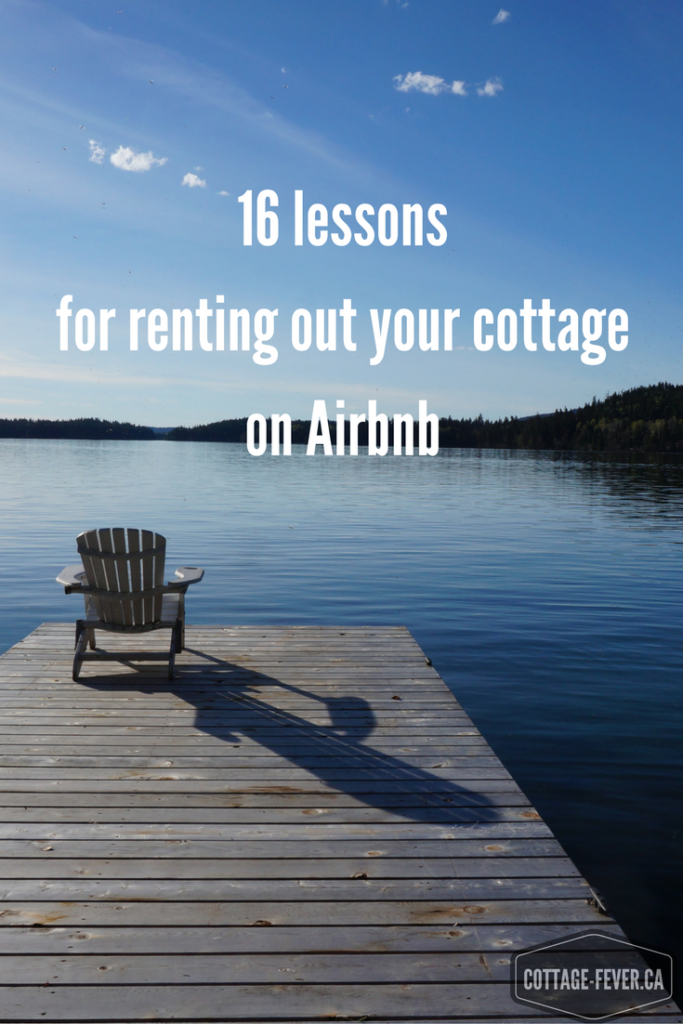
Lessons learned from renting out the cottage:
- Decide on the online rental service that’s right for you. Some good ones are: Airbnb, VRBO, Homeaway
- Declutter and depersonalize
- Take great pictures, giving a sense of what the guests will experience
- Be honest in describing the listing
- Communicate quickly once you get a booking request
- Send a welcome message before check-in
- Touch base during the stay
- Ask for the review
- Continually edit your listing description based on the questions you’re being asked and to help with the algorithm
- Note how much notice you allow for a booking request – for instance need at least two days notice to arrange for cleaning
- Use the calendar to block off the dates you want to use the cottage
- You don’t have to accept everyone but you CANNOT discriminate against anyone
- Check out your potential guests reviews and ensure that they have been verified by Airbnb
- Let the neighbours know you’re renting out your cottage
- Insurance – while Airbnb has a “host guarantee“, this does not take the place of your cottage insurance.
- Rental income is income and you need to declare it but save all your receipts for deductions
Have you rented out your place? What was your experience like? Be sure to leave a comment below!
If you’d like to see how I’ve set up my own airbnb, here it is: airbnb.com/h/thebeachchalet
Need help designing your airbnb?
I’m an Interior Designer who can work virtually to design your airbnb. Please visit my Interior Design Services page to learn more.
Shop for products to set up your Airbnb

This post contains affiliate links. If you decide to rent out using Airbnb, you’ll receive a $34 incentive.

